Search and rescue efforts at the crash site of TransAsia Airways (復興航空) Flight GE235 continued in cold and rainy weather in Taipei yesterday, with 12 of the 58 people onboard still unaccounted for as of press time last night.
The death toll rose to 31 yesterday.
The Civil Aeronautics Administration (CAA) said that one body was yet to be identified.
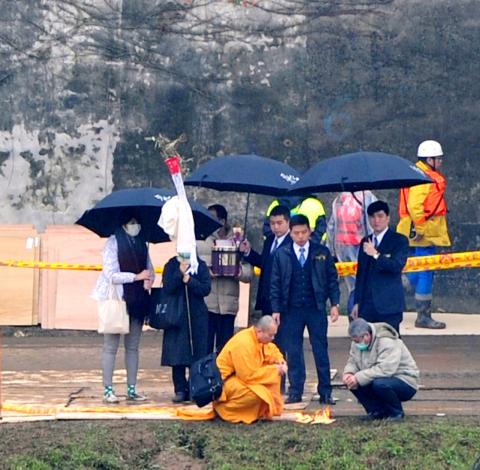
Photo: CNA
Rescue efforts continued early yesterday morning after a brief halt from 1am to 6:30am due to safety concerns.
As of press time, the latest body pulled from the wreckage of the ATR-72 600 turboprop plane — which plunged into the Keelung River (基隆河) in Nangang District (南港) at about noon on Wednesday — was retrieved from the cabin.
Flight GE235 sent out a mayday message shortly after it took off from Taipei International Airport (Songshan airport) before clipping a guardrail of the Huandong Expressway — as well as a taxi on the roadway — with its left wing before crashing into the river just a few kilometers from the runway.
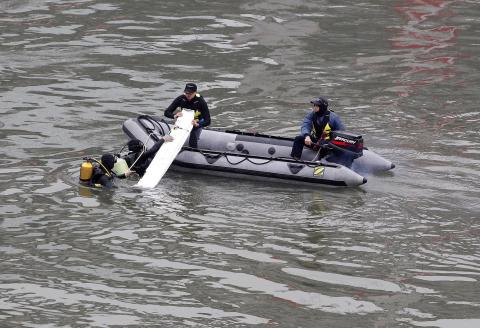
Photo: Pichi Chuang, Reuters
While the tail and nose of the aircraft were hoisted from the river last night, a wing remained stuck in mud. Parts of the plane’s body have been found scattered as far as 6km downstream.
Sixty divers in 20 boats scoured the main wreckage site and 4km of downstream riverbed, while sonar and hooks were also used to search for wreckage or bodies.
A diver surnamed Kao (高) said the search operation could only move slowly because low visibility forced divers to feel their way across the river bed.
“The worry is that because bodies have not been found after a carpet search, they have already moved downstream,” Taipei Mayor Ko Wen-je (柯文哲) said after an evening inspection of the crash site.
“Finding them tomorrow [today] will not be easy, because we do not know how far the search should be expanded downstream,” Ko added.
He added that while an interception line had been stretched across the river downstream to catch any floating remains, it would be ineffective if bodies were submerged.
Armed forces have mobilized various units to assist in the search-and-rescue operation, as well as helping with the recovery of the airplane’s fuselage.
The Republic of China (ROC) Army 53rd Engineering Corps from the Guandu Area Command arrived at the crash site with heavy-lift hoist vehicles and M3 amphibious rigs to construct temporary bridges to facilitate the operation, while divers from the ROC Navy Underwater Operations Unit with eight rubber rafts went into the river to search for airplane debris and bodies.
Over the past two days, 420 soldiers and officers have assisted in the operation, which also included the ROC Air Force 141 Squadron, 202nd Military Police Regiment, units from the Armed Forces Reserve Corps and medical staff from military hospitals across Taipei, the Ministry of National Defense said.
Twenty-two of the 31 people confirmed killed were from two Chinese tour groups that were on their way back home.
China’s Xiamen Tourism Bureau deputy director Chen Guiling (陳桂林) arrived in Taiwan with travel agency operators to get first-hand information on the accident.
Meanwhile, 32 family members of the Chinese passengers also arrived in Taiwan to identify bodies.
The Aviation Safety Council said that it has finished decoding data on the flight and cockpit voice recorder, adding that details garnered from both black boxes could be released this afternoon.
Council director Thomas Wang (王興中) said that representatives of ATR 72 aircraft and engine manufacturers would arrive from France and Canada respectively to attend a meeting at the council this morning, in which they would verify the data from black boxes.
The French Bureau of Inquiry and Analysis for Civil Aviation Safety and the Canadian Transportation Safety Board would dispatch representatives to assist the council to investigate the cause of the crash, Wang said.
In light of the accident, the CAA has ordered both TransAsia and Uni Air (立榮航空) to conduct a special inspection of all their ATR 72 aircraft.
Uni Air has 12 ATR 72-600 planes, whereas TransAsia has six ATR 72-500 planes and four ATR 72-600s.
CAA Director General Lin Tyh-ming (林志明) yesterday said that TransAsia had finished examining all of its ATR 72 planes, adding that Uni said it would finish inspecting its aircraft tomorrow.
Due to the inspections, TransAsia canceled 30 domestic flights, including those between Taipei and Kinmen, between Taipei and Magong, between Taipei and Hualien, between Kaohsiung and Magong and between Kaohsiung and Kinmen.
Additional reporting by CNA
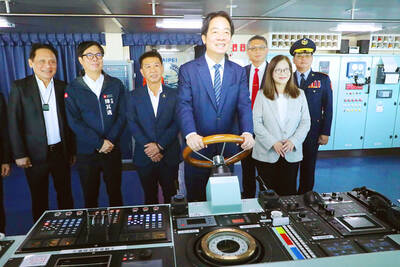
CALL FOR SUPPORT: President William Lai called on lawmakers across party lines to ensure the livelihood of Taiwanese and that national security is protected President William Lai (賴清德) yesterday called for bipartisan support for Taiwan’s investment in self-defense capabilities at the christening and launch of two coast guard vessels at CSBC Corp, Taiwan’s (台灣國際造船) shipyard in Kaohsiung. The Taipei (台北) is the fourth and final ship of the Chiayi-class offshore patrol vessels, and the Siraya (西拉雅) is the Coast Guard Administration’s (CGA) first-ever ocean patrol vessel, the government said. The Taipei is the fourth and final ship of the Chiayi-class offshore patrol vessels with a displacement of about 4,000 tonnes, Lai said. This ship class was ordered as a result of former president Tsai Ing-wen’s (蔡英文) 2018
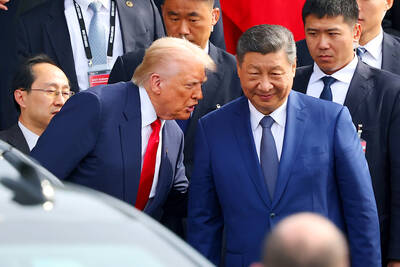
UKRAINE, NVIDIA: The US leader said the subject of Russia’s war had come up ‘very strongly,’ while Jenson Huang was hoping that the conversation was good Chinese President Xi Jinping (習近平) and US President Donald Trump had differing takes following their meeting in Busan, South Korea, yesterday. Xi said that the two sides should complete follow-up work as soon as possible to deliver tangible results that would provide “peace of mind” to China, the US and the rest of the world, while Trump hailed the “great success” of the talks. The two discussed trade, including a deal to reduce tariffs slapped on China for its role in the fentanyl trade, as well as cooperation in ending the war in Ukraine, among other issues, but they did not mention
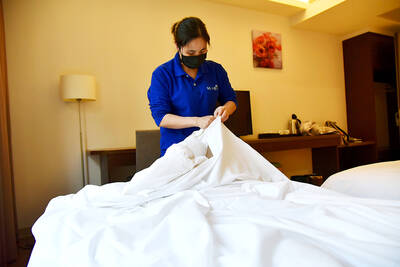
HOTEL HIRING: An official said that hoteliers could begin hiring migrant workers next year, but must adhere to a rule requiring a NT$2,000 salary hike for Taiwanese The government is to allow the hospitality industry to recruit mid-level migrant workers for housekeeping and three other lines of work after the Executive Yuan yesterday approved a proposal by the Ministry of Labor. A shortage of workers at hotels and accommodation facilities was discussed at a meeting of the legislature’s Transportation Committee. A 2023 survey conducted by the Tourism Administration found that Taiwan’s lodging industry was short of about 6,600 housekeeping and cleaning workers, the agency said in a report to the committee. The shortage of workers in the industry is being studied, the report said. Hotel and Lodging Division Deputy Director Cheng

TOKYO SUMMIT: The new Japanese PM’s words have demonstrated Japan’s ‘firm position on urging the prioritization of cross-strait peace,’ the foreign ministry said Minister of Foreign Affairs Lin Chia-lung (林佳龍) yesterday thanked US President Donald Trump and Japanese Prime Minister Sanae Takaichi for supporting peace in the Taiwan Strait, a day after the two at a summit in Tokyo emphasized the importance of regional stability and ahead of a meeting between Trump and Chinese President Xi Jinping (習近平) in South Korea today. The previous day’s meeting was the first time Takaichi had met with the US leader since becoming Japanese prime minister, the Ministry of Foreign Affairs said in a statement. Since taking office on Tuesday last week, Takaichi has urged the international community to